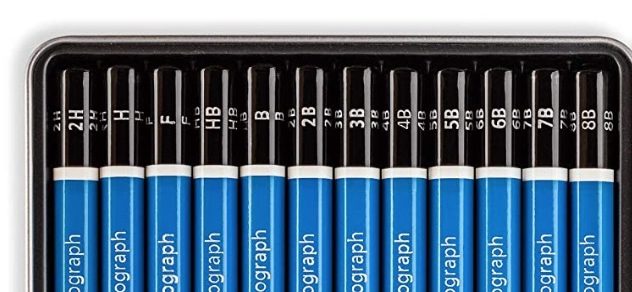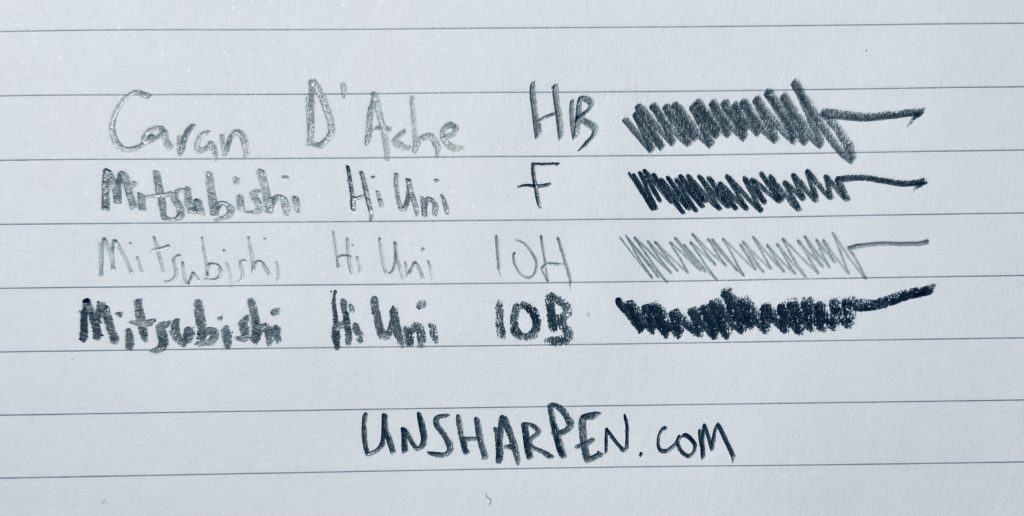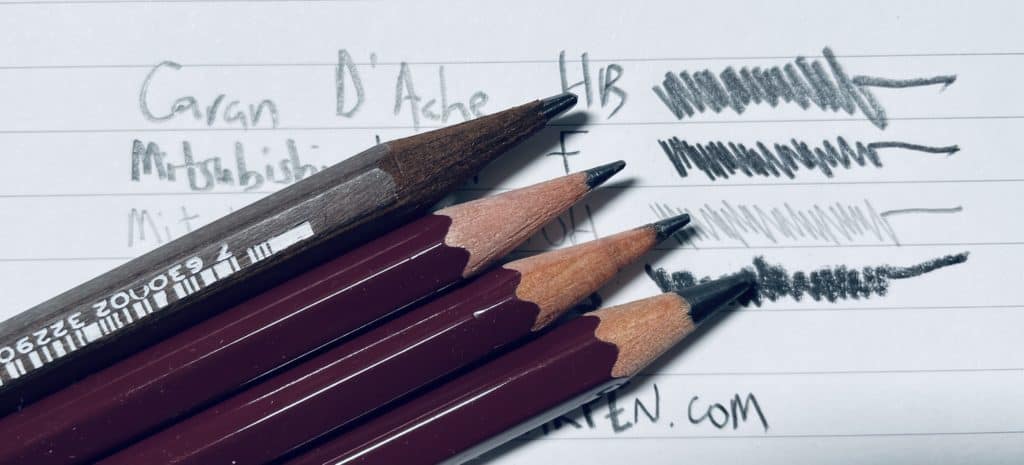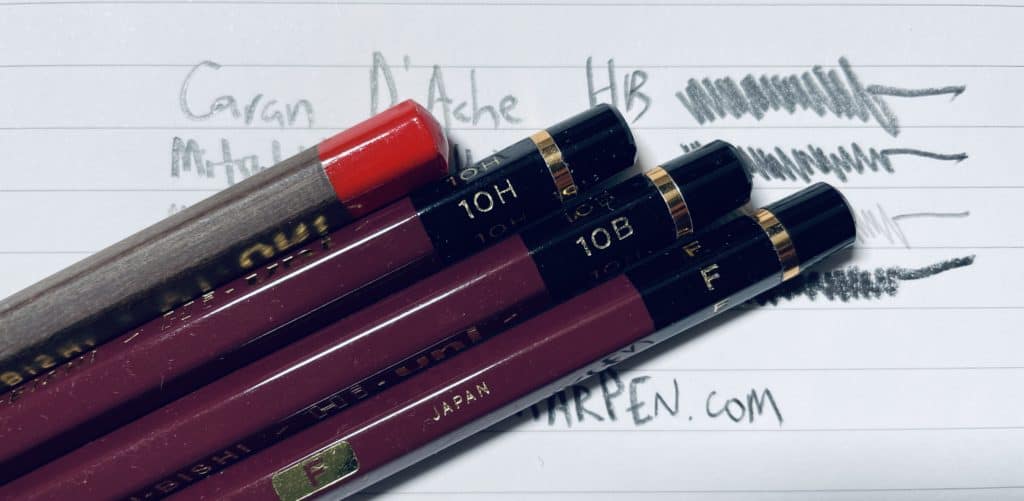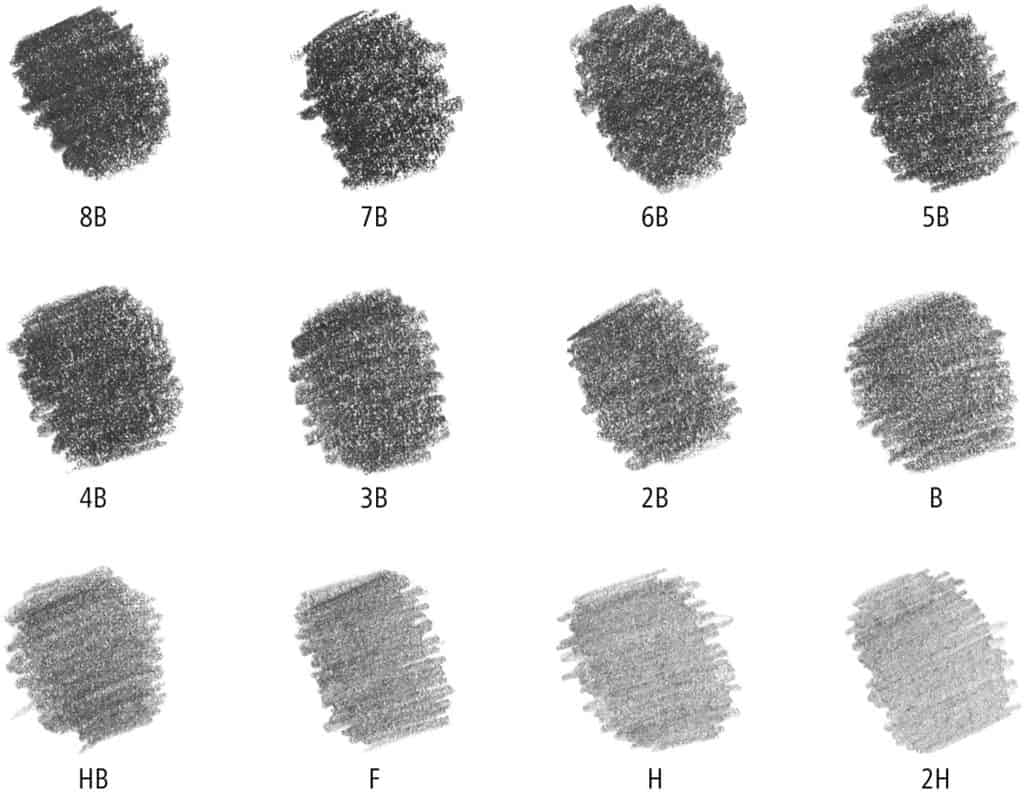Every pencil, whether it’s a mechanical pencil or wooden pencil, has a lead and every lead has a grade. But which lead grade should you use? Which is best for a test? Which is best for art? How about note taking?
What Is Lead Grade?
Pencil lead is made with proprietary mixtures of materials which vary from one manufacturer to another. They all use essentially the same stuff — graphite, clay, and so on — but the exact materials and proportions differ. So how can you tell a pencil from one company is going to write the way another company’s pencil does?
Manufacturers have settled on a lead grading system that give a code based on the hardness and darkness of the lines left by the pencil lead. There is no internationally accepted standard around this so there is no truly uniform method (the way there is with pen refills sizes for instance) so Tombow’s HB might not be the same as Uni’s HB, but they should be pretty close.
Most pencils makes will add a code to the pencil that uses:
- H – for hardness
- B – for blackness
in order to sort their pencils.
A common, everyday pencil you’d grab from the store is an HB — it’s hard and black in the expected levels. You will see the number of Hs increase as the pencil gets harder and the number of Bs increase as the pencil lead gets blacker. For example 2B is short for BB and it’s a pencil that is more black than a HB but less hard than a 2H.
If you think of it as a spectrum you have 10H on one side, HB in the middle, and 10B on the other side.
Some manufacturers, usually those in Japan, use an “F” for firm, which is similar to an HB, but then will continue with the stacked Bs and Hs.
Lastly, HB is the same as the American standard #2 pencil, the one you are supposed to use for taking standardized tests which are read by scanners.
American Scale
As touched on above, pencils made in America have classically used a based on numbers. Commons grades in this scale are:
- #1 – A very soft pencil
- #2 – A soft pencil. The standard pencil for electronic test scoring and the most common pencil grade
- #2.5 – Medium soft pencil
- #3 – Hard pencil
- #4 – Very hard pencil used for making sharp lines
This rating system is clearly less specific than the international scale and while it has persisted through the years, it doesn’t have the same range either. This is why even American manufacturers tend to switch over to the international scale for their artist series pencils.
It’s possible to translate from the American scale to the international one, though grades vary from brand to brand so this isn’t an exact standard. The equivalency is normally:
- #1: 2B
- #2: HB
- #3: 2H
- #4: 4H
What To Expect From Each Lead Grade
Keeping in mind that the grades are not necessarily equivalent from one company to another, they are directionally the same. This means you can look at the grade on a pencil and know roughly what to expect from it, you just can’t expect it to be exactly the same thing another company would order.
This scenario is similar to the color of a pen — buy a blue pen from Bic and then a blue pen from Paper Mate. You’ll know the color is going to be blue, but you don’t expect they will be exactly the same shade of blue.
As you move from HB up the B scale, you can expect the lead to get softer feeling and smoother as you write. The pencil will get more like charcoal. The writing will get increasingly smoother and the lines will get darker. The pencil strokes will have lots of smudging, making them worse for lefties but they will be easier to erase.
The most common grade in the US (sometimes seen as F in Asia) is the equivalent of the American #2 pencil, the one we all used on the ACT, SAT, and other similar tests. This is a good middle ground between legibility (which increases as you add Bs) and limiting smudges (which increases as you add Hs).
High count of Hs (like 8H) will have a hard lead that scratches when you write with it and has a brittle feeling to it. The lines on the page will get very light, with the grey color getting harder and harder to read as you move up the scale. Lefties will benefit from moving from an HB up a few H grades (like 2H) in order to reduce smudging.
Choosing A Lead Grade
Much of the choice of a pencil’s lead grade will come down to individual preference, but here is some guidance that might help you by providing a starting point.
- Students: HB or F
- Left-handed: 2H
- Artists: An art set like the Staedtler Mars Lumograph will include a 6 pencil range (8B, 7B, 6B, 4B, 2B, and HB)
- Note-taking: 2H
- Mathematics: 2B
Lead Grades Visual Guide
Here are samples of the Staedtler Lumograph drawing pencil’s lead grade range…
FAQs
Do mechanical pencils use lead grades?
Yes, mechanical pencils do use lead grades. This is to say that a number of lead hardness levels are sold in mechanical pencil lead, but not as wide a range as in wooden pencils. Typically you’ll see a high quality lead, like Uni’s NanoDia sold in 4B, 2B, B, HB, H, 2H, and 4H. The far ends of the spectrum, like 8B, will be removed as the lead would not be practical in a small 0.5 mm (or so) package.
